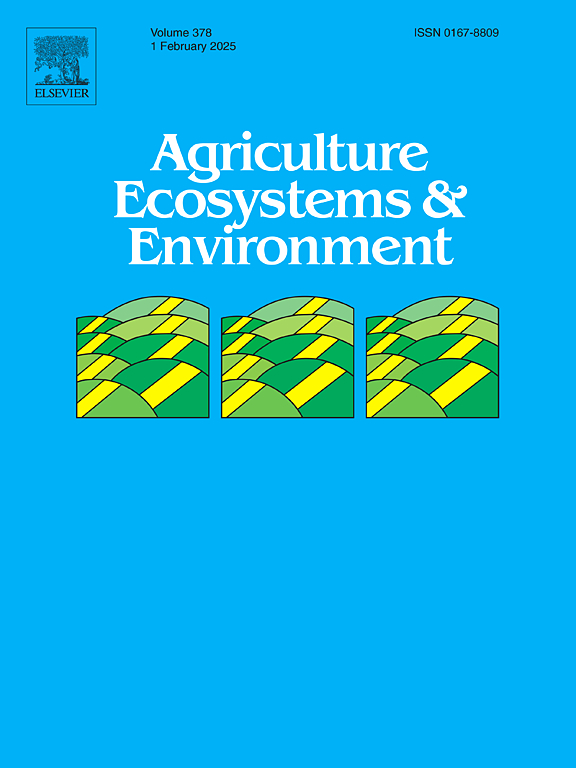Actinobacteria derived from soybean/corn intercropping influence the subsequent wheat
IF 6
1区 农林科学
Q1 AGRICULTURE, MULTIDISCIPLINARY
引用次数: 0
Abstract
Soil legacy effects, especially soil bacterial legacy effects, influence growth, fitness and nutrient acquisition in sequential cropping systems. To date, mechanisms underlying soil bacterial legacy influences on subsequent crops remain largely unknown. In this study, we employed soybean monoculture (S), corn monoculture (C), and soybean/corn intercropping (SC) to study soil legacy effects on the growth and nutrient acquisition of wheat. In these tests, S, C and SC drove establishment of distinctive soil bacterial communities, with higher abundances of Actinobacteria and Proteobacteria taxa observed in SC plots than in S and C treatments. Variation among soil bacterial communities was associated with functional shifts in nitrogen cycling in SC treatment compared to other treatments(C and Control). Soil legacy effects in turn may contribute to growth, nutrient acquisition and grain production in wheat crops planted in rotations. Pot assay suggest that soil microorganism of SC treatment significantly increased the plant height of wheat by 15.1 % and 18.7 %, the shoot biomass by 50.7 % and 62.7 %, the nitrogen content by 76.0 % and 94.9 %, the phosphorus content by 80.3 % and 75.9 %, and the potassium content by 64.0 % and 83.7 % by compared with C and S. Actinobacteria taxa collections further promote nutrient acquisition of wheat. Taken together, our observations from field plots and manipulation of specific bacterial taxa revealed novel soil bacterial legacy effects of previously reared crops on subsequent crops. These new insights open avenues for using soil legacy effects for positive impacts in crop rotation systems.
大豆/玉米间作产生的放线菌对后续小麦的影响
土壤遗留效应,尤其是土壤细菌遗留效应,会影响连作系统的生长、适应性和养分获取。迄今为止,土壤细菌遗留效应影响后茬作物的机制在很大程度上仍然未知。在本研究中,我们采用了大豆单作(S)、玉米单作(C)和大豆/玉米间作(SC)来研究土壤遗留物对小麦生长和养分获取的影响。在这些试验中,S、C 和 SC 驱动建立了独特的土壤细菌群落,与 S 和 C 处理相比,在 SC 地块观察到的放线菌和蛋白质细菌类群的丰度更高。与其他处理(C 和对照)相比,SC 处理中土壤细菌群落的变化与氮循环的功能转变有关。土壤遗留效应反过来可能有助于轮作小麦作物的生长、养分获取和粮食产量。盆栽试验表明,与C和S处理相比,SC处理的土壤微生物显著增加了小麦株高的15.1%和18.7%,增加了嫩枝生物量的50.7%和62.7%,增加了氮含量的76.0%和94.9%,增加了磷含量的80.3%和75.9%,增加了钾含量的64.0%和83.7%。总之,我们对田间地块的观察和对特定细菌类群的处理揭示了以前饲养的作物对后来作物的新的土壤细菌遗留影响。这些新见解为利用土壤遗留效应在轮作系统中产生积极影响开辟了道路。
本文章由计算机程序翻译,如有差异,请以英文原文为准。
求助全文
约1分钟内获得全文
求助全文
来源期刊

Agriculture, Ecosystems & Environment
环境科学-环境科学
CiteScore
11.70
自引率
9.10%
发文量
392
审稿时长
26 days
期刊介绍:
Agriculture, Ecosystems and Environment publishes scientific articles dealing with the interface between agroecosystems and the natural environment, specifically how agriculture influences the environment and how changes in that environment impact agroecosystems. Preference is given to papers from experimental and observational research at the field, system or landscape level, from studies that enhance our understanding of processes using data-based biophysical modelling, and papers that bridge scientific disciplines and integrate knowledge. All papers should be placed in an international or wide comparative context.
 求助内容:
求助内容: 应助结果提醒方式:
应助结果提醒方式:


